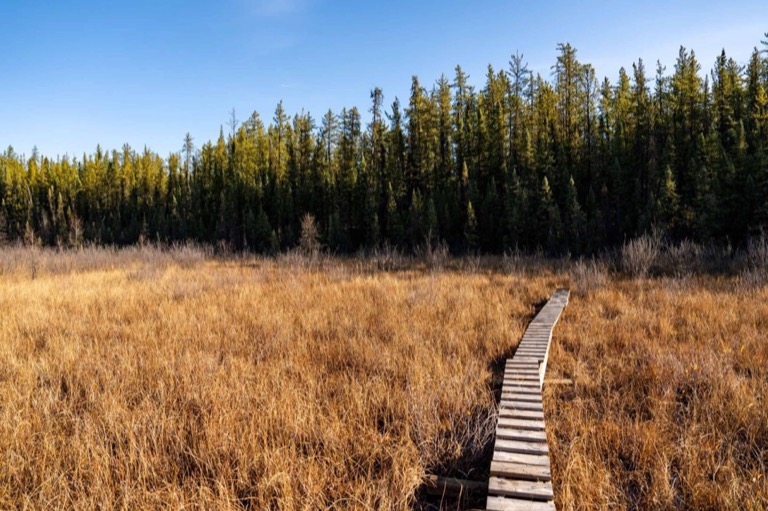Overview
Ambient Air Monitoring
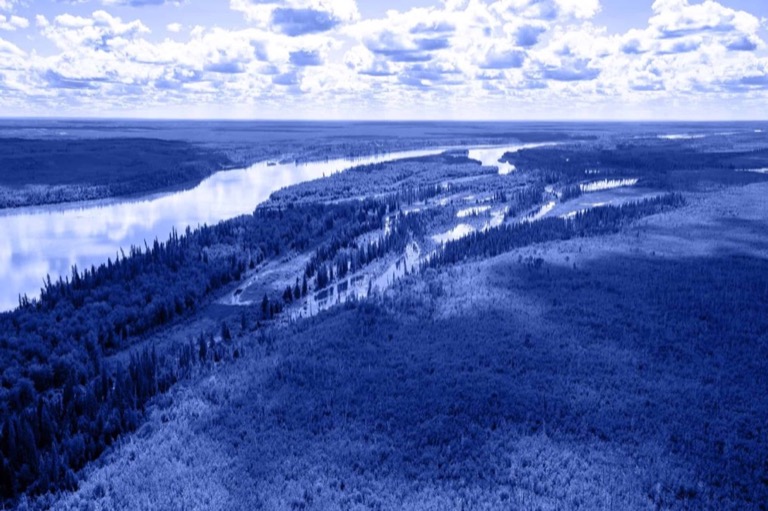
The past year invited an opportunity for the WBEA to reflect on its guiding principals, and plan for a successful, sustainable future.
With the release of our 2022 – 2026 Strategic Plan, the WBEA outlined seven organizational milestones, which are summarized in the following four strategies:
The WBEA’s vision for the future also necessitated our growth. We were pleased to establish the Indigenous Relations and Community Liaison role as a permanent addition to our team. With this position, the WBEA will focus on demonstrating respect for Indigenous Ways of Knowing through engaging with our community partners and centering Traditional Knowledge (TK) in our programs.
To better understand the needs and expectations of our stakeholders, the WBEA initiated the Network Assessment project in 2022. Through collaboration and purposeful engagement, the WBEA aims to establish a new strategic direction for our Ambient Air Monitoring (AAM) network in the very near future.
It is our intention that the information found in the 2022 Annual Report will empower our stakeholders and rightsholders to effect positive change, make informed decisions, and ensure a safe and healthy environment today, and in the years to come.
The WBEA has had a long-standing presence in the region, officially since 1997. To learn more about the organization, including our governance structure, partnerships, and our past, present, and vision for the future, visit the About section of our website.
To empower all stakeholders and rights holders with environmental data to make informed decisions.
The Wood Buffalo Environmental Association is a multi-stakeholder, consensus-based organization providing worldclass environmental monitoring and reporting.
The General Members Board and Governance Committee provide strategic direction and oversight for the organization. The Technical Committees determine the strategic plans and direction for each of the WBEA's monitoring programs. The Executive Director provides operational direction for the WBEA staff, engaging science and technical advisors as required, to ensure stewardship to the overarching direction set by the General Members Board and Governance Committee.
 Ambient Air - Continuous Sites
Ambient Air - Continuous Sites
 Regional Meteorology Towers
Regional Meteorology Towers
 Remote Ozone Sites
Remote Ozone Sites
 Deposition - Forest Health Sites
Deposition - Forest Health Sites
 Deposition - Ion Exchange Resin Sites
Deposition - Ion Exchange Resin Sites
 Deposition - Denuder Sites
Deposition - Denuder Sites
NOTE: No portable Ozone monitors were deployed in 2022.
This map shows the locations for all monitoring stations in 2022 within the WBEA monitoring network.
For more information on these stations, please visit wbea.org/network-and-data/monitoring-stations.
Overview
Ambient Air Monitoring
Overview
Deposition Monitoring
Overview
Odour Monitoring
Overview
Community-Based
Monitoring
The WBEA is fortunate to work with partners across the province, including Alberta Environment and Protected Areas, the Oil Sands Monitoring Program, and Alberta Airsheds Council. The WBEA acknowledges the financial support of the Oil Sands Monitoring Program. To learn more about the WBEA's involvement with these partnerships, visit:

The WBEA operated about 30 ambient air monitoring (AMS) stations throughout the RMWB in 2022. These included industrial, attribution, community, background, and meteorological stations.
The WBEA’s Ambient Air Monitoring (AAM) Program activities function to address multiple objectives, scientific questions, and requirements set by global, national, provincial, and regional jurisdictions. The WBEA’s website highlights each of these specifically and how they relate to the WBEA’s monitoring network activities.
When ambient concentrations of any air pollutant the WBEA measures exceed the Alberta Ambient Air Quality Objectives and Guidelines (AAAQOs & AAAQGs), which are set provincially, the WBEA has an Immediate Reporting Protocol that is put into action.
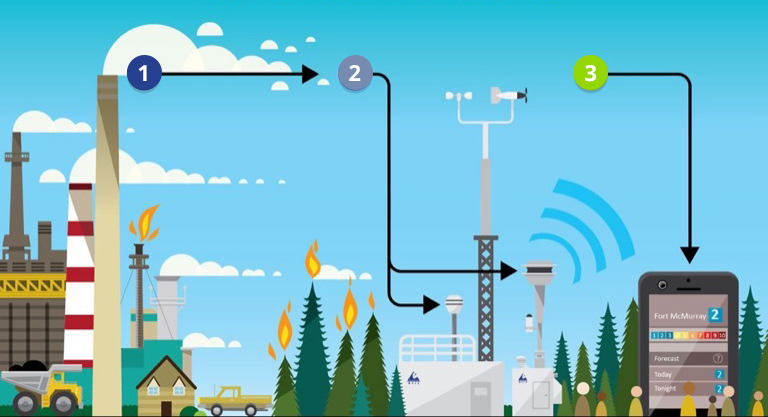
Source
Pollution is emitted into the air from a variety of sources.
Measure
The WBEA ambient air monitoring stations measure the concentrations of pollutants in the air.
Share
The information the WBEA collects is available to view and is used to calculate the air quality health index (AQHI).
Alberta’s Air Quality Health Index—AQHI—is a scale created to help individuals better understand the impact of air quality on their health by providing important ambient air data at a glance. The graphs below show the percentage of time each community station reported each risk level during 2022. Visit wbea.org to access near real-time values for and to learn more about AQHI and Fort McKay Air Quality Index (FMAQI).
Low Risk 98.61%
Moderate Risk 1.02%
High Risk 0.35%
Very High Risk 0.02%
Low Risk 97.26%
Moderate Risk 2.44%
High Risk 0.28%
Very High Risk 0.02%
Low Risk 99.28%
Moderate Risk 0.47%
High Risk 0.20%
Very High Risk 0.05%
Low Risk 97.31%
Moderate Risk 2.56%
High Risk 0.11%
Very High Risk 0.02%
Low Risk 97.66%
Moderate Risk 2.13%
High Risk 0.21%
Very High Risk 0.00%
Low Risk 98.25%
Moderate Risk 1.56%
High Risk 0.15%
Very High Risk 0.04%
Low Risk 97.10%
Moderate Risk 2.42%
High Risk 0.26%
Very High Risk 0.22%
The WBEA’s ambient air quality data is compared to several established air quality thresholds, triggers, and limits. Air quality events occur when the concentration of ambient air detected by the WBEA exceeds the standards set by the Alberta Ambient Air Quality Objectives (AAAQO), and indicators identified by the Alberta Ambient Air Quality Guidelines (AAAQG). When an exceedance occurs the WBEA follows the guidance of the Air Monitoring Directive and reports each occurrence to the appropriate governing bodies.
The WBEA has developed an Air Quality Events (AQE) app as another way to notify interested stakeholders and partners of air quality events related to AAAQO’s and AAAQG’s. The AQE app provides near-real time notifications when an exceedance occurs in the network and allows users to subscribe to the air monitoring stations of interest. The app is available for download to all iOS platforms. In addition, the AQE app stores all the historical and near real-time air quality events information on the Air Quality Events page of the WBEA website.
The first graph below presents a total count of air quality exceedances at all WBEA ambient air monitoring stations over a five-year period for AAAQOs from 2018-2022. Since the PM2.5 1-hour AAAQG was established in 2019, exceedance data available from 2019 to 2022 are included in the graph. The second graph shows the exceedances for 2022 based on station locations.
Note: Values may be too small to be visible on some graphs. Hover over the graph to view specific values.
Note: Forest fire season was considered to be from March 1 – October 31, 2022.
Note: The WBEA began reporting PM2.5 AAAQG exceedances in 2019 as per the Alberta Air Monitoring Directive (AMD) requirements; the graph shows exceedance data for 2019 to 2022.
Note: Forest fire season was considered to be from March 1 – October 31, 2022.
The Lower Athabasca Regional Plan (LARP) has existed as an extension of the Alberta Land-Use Framework since September 2012.
The LARP air quality objective is to manage releases from multiple sources, so they do not collectively result in unacceptable air quality. LARP sets out trigger levels and limits for NO2 and SO2 as described in the table below. The WBEA provides AEP with the air quality data that is used to calculate the annual LARP triggers and limits. When a trigger is exceeded, AEP is required to create a regional management response.
The following graphs show the annual average and hourly 99th percentile concentrations of NO2 and SO2 at each station location compared to the respective triggers and limit for each parameter. The use of the hourly 99th percentile data is a statistical measure to indicate upper limits of the data. Increases in the 99th percentile beyond the LARP triggers can be an early warning to help inform appropriate management actions to prevent future exceedances.
Learn more about LARP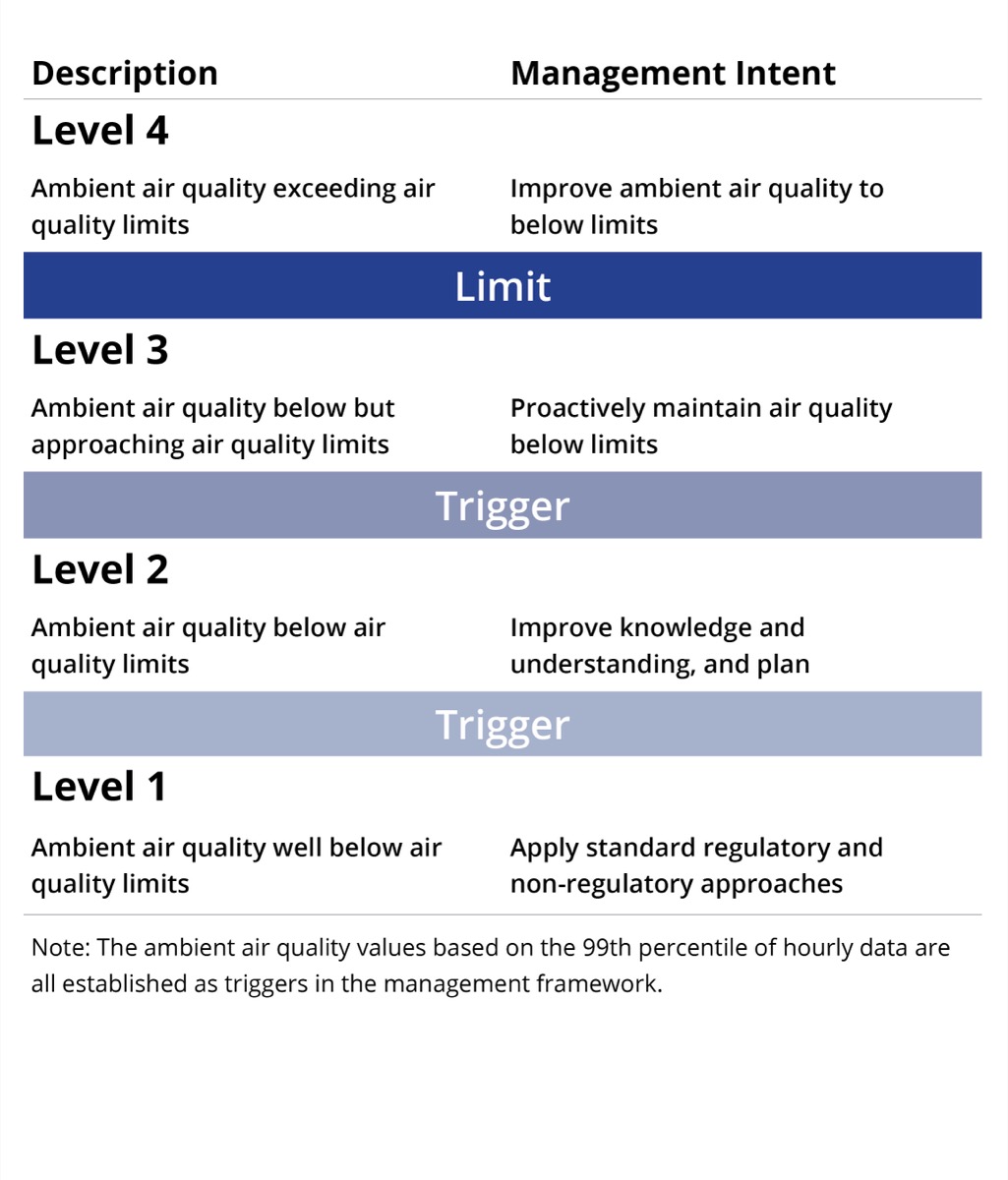
Meteorological parameters, including wind speed and direction, humidity, precipitation, atmospheric pressure, solar radiation, and the vertical temperature structure of the atmosphere, all impact the dispersion, deposition, and transformation of common air pollutants.
Wind rose plots are a visual representation of the wind profile for a specific location, showing wind speed and wind direction for communities within the WBEA network. The position relative to the centre of the wind rose represents the direction which wind is blowing from. The magnitude of the slice represents the frequency which the wind blows from that direction. The colours within each wind rose triangle represent the wind speeds when blowing from that direction (shown in the legend above the wind roses).
For example, the largest triangle in the Fort Chipewyan wind rose shows the wind comes from the East approximately 17% of the time in 2022.
Calms: 0.07%
Tower Height: 20m
0.5 - 5
5 - 10
10 - 15
15 - 20
20 - 25
>= 25
Two key sampling methods are used by the WBEA for conducting high quality ambient air monitoring within its network: continuous, which generates raw air quality data in near real-time, and time-integrated or “non-continuous”.
View parameters measured at each stationThe graphs below provide an overview of each parameter measured, including its sampling method, in 2022.
As its title suggests, the WBEA’s continuous ambient air monitoring uses analyzers that continually measure concentrations of pollutants in the air. This data is readily available to anyone in near real-time on our website, wbea.org.
In addition to specific compounds, all stations continuously measure temperature, relative humidity, and wind speed and direction.
The data for continuous monitoring is presented in the following graphs as the annual hourly average (mean) concentrations of each parameter, along with the annual hourly 99th percentile and maximum concentrations. Please note, the averages may be too small to be visible on some graphs. The annual hourly 99th percentile is used to show the high end of concentrations measured at the WBEA air monitoring stations, after removing the highest 1% of events which may be outliers.
Note: Averages may be too small to be visible on some graphs. Hover over the graph to view specific values.
Sulphur dioxide (SO2) – SO2 is produced from the combustion of sulphur-containing fossil fuels. Sulphur dioxide in the air at high concentrations can make breathing difficult, particularly for children, the elderly, and people with asthma. SO2 reacts in the atmosphere to form sulphuric acid and acidic aerosols, which contribute to acid deposition and acid rain.
Time-integrated sampling provides more detailed analysis of species present in ambient air, and supplements continuous monitoring which reports a total concentration in real-time. Time-integrated monitoring methods consist of exposing sample media to the atmosphere for a period of time, then collecting and sending that media a laboratory for analysis.
The WBEA's time-integrated sampling data is available at https://wbea.org/data/time-integrated-data-search/. The data for time-integrated monitoring methods is presented in the graphs below as the annual average (mean) of 24-hour sample concentrations, along with the 95th percentile to show readings on the high-end of the data collected, after removing the highest 5% which may be outliers. There are numerous species collected, however, the graphs show the nine (9) or ten (10) parameters with the highest concentrations in 2022.
Note: Select which parameter you would like to view, and then use the drop-down menu to select an air monitoring station.
Note: Averages may be too small to be visible on some graphs. Hover over the graph to view specific values.
Particulate matter less than 2.5 µm Ions - Particulate matter consists of a mixture of solid particles and aerosols found in the air. PM2.5 is the fraction of total particulate that are 2.5 μm (microns) in diameter or less, and is produced mainly by combustion processes, including forest fires.
Typically, exceedances of the PM2.5 AAAQO in the WBEA network are a result of forest fires. Fine particles are composed primarily of sulphate, nitrate, ammonium, inorganic and organic carbon compounds, and heavy metals. PM2.5 poses a health risk as the particles can be inhaled deep into the lungs.
The continuous analyzer measures the concentration of particulate matter in the air at any given time. A time-integrated PM2.5 sample is a measure of dry deposition and is analyzed for major ions similar to the wet deposition samples, and metals that make up the particulate matter in the air.
Note: Forest fire season was considered to be from March 1 – October 31, 2022.

The Deposition Monitoring program, also referred to as the Terrestrial Environmental Effects Monitoring (TEEM) program, was established to address community, industry, and government concerns about impacts to regional forests from industrial development.
The objective of the program is to determine cause-effect relationships between air pollutants and forest ecosystem health in the region. To meet this objective the WBEA operates both a long-term Forest Health Monitoring Program and an Atmospheric Pollutant Deposition Monitoring Program which monitor stressors (acidification/eutrophication) along the pathway (atmospheric transport) from source (industrial emissions) to the receiving environment (jack pine forests).
To understand changes in regional deposition over time, data derived from the program must be integrated and analyzed every several years. The most recent comprehensive analysis of historical data was completed in 2019. At that time, the WBEA developed 75 recommendations for program improvements and also published nine open access manuscripts in a Virtual Special Issue of the journal Science of the Total Environment. The issue, entitled “Relationships Between Air Pollutants and Forest Ecosystem Health in the Oil Sands Region, AB, Canada”, is available online here.
In 2022, the WBEA completed the next data analysis exercise that will be published in 2023. This publication will supplement the previous findings and continue to explore changes in deposition over time. In addition, the WBEA continued to address the program recommendations by finalizing the evaluation of all Deposition Monitoring programs. In late 2022, the TEEM Technical Committee approved proposals for an optimized deposition network, which includes strategic placement and use of ion exchange resins, passives, remote ozone monitors, and denuders, to yield better spatial resolution and higher data quality.

Source
Pollution is emitted into the air from a variety of sources.
Deposit
The pollution may be deposited onto the surrounding forest.
Measure
The WBEA collects samples and information to measure the effect of pollution on the enviroment.
The Forest Health Monitoring program monitors jack pine forest sites to assess whether there are changes to biological, physical, and chemical indicators through a sampling campaign of soils and vegetation every 6-years, as well as lichen sampling at varying intervals. During initial program development, the upland jack pine (Pinus banksiana) ecosystem was identified as the most sensitive receptor to acidification due to their characteristically dry, nutrient poor soils with limited buffering capacity. In these ecosystems, the effects of acid deposition are expected to be observed in a cascading manner from soils to vegetation, first impacting individual organisms, then the tree stand, and onward to landscape level impacts. The bigger impacts will take a longer time but will be harder to correct. This concept is depicted in the Critical Load Graph.
In 2022, the WBEA completed the extensive task of cleaning over 150 lichen samples before submission to the lab for analysis. These lichen samples, of the species Hypogymnia physodes, were collected in 2021 as part of the regional lichen monitoring program from all over the region, as shown on the adjacent map. This species of lichen receives its nutrients from the air and rain making it a very effective natural tool for monitoring air pollution. Data obtained from these samples is critical to the program and is used to determine changes in atmospheric deposition over time and across the regional landscape.
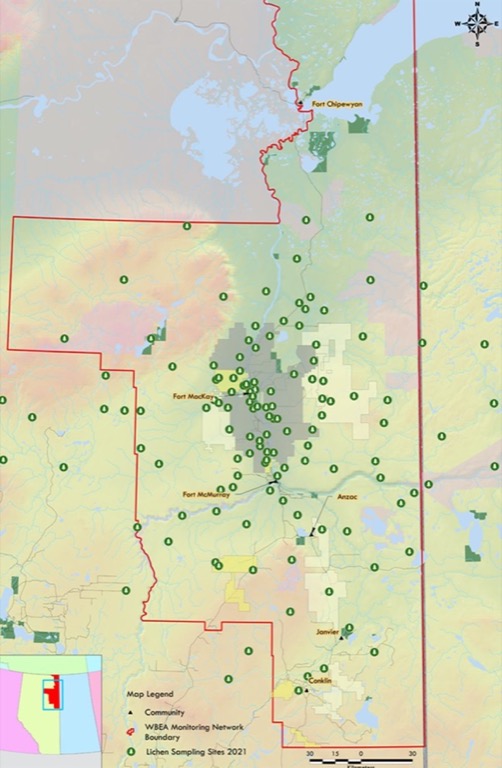
Passive air sampling, specifically using passive samplers, is a cost-effective method for coverage of a broad spatial range, including remote locations, because they have no moving parts and require no power. Passive sampler data, along with meteorological data, is used to model deposition trends. In 2022, the WBEA finalized a program evaluation and approved a new passive program for 2023 that will focus on NO2 and O3 in strategic locations, co-located with active air sampling. The new program will provide adequate spatial coverage for deposition estimates in the region while being cost-effective.
Active air sampling uses a pump to provide a known volume of air to a continuous analyzer or sample media. For this reason, in addition to a low detection limit, active air sampling provides higher quality data than passive air sampling, however, because they require power, they can be less versatile. In 2022, ammonia (NH3) and nitric acid (HNO3) continued to be monitored monthly at eight sites using solar-power annular denuder systems. In addition, the WBEA finalized a program evaluation and approved an expansion of the denuder network, to be executed in 2023, which will provide better qualitative data.
Ion exchange resin (IER) technology is a passive sampling technology, comprised of a column of resin beads that capture anions and base cations to characterize spatial gradients of atmospheric deposition of nitrogen, sulphur, and base cations in the region. IERs are critical to the deposition program as they provide actual deposition measurements required to validate the critical loads mapping and modelling exercises. In 2022, the WBEA finalized a program evaluation and approved an optimized IER program that includes an increase in base cation collection, a change that was due to recent findings that suggest base cation deposition plays a greater role in deposition effects than anticipated during the developmental years of the program.
The WBEA's regional meteorological network provides key data for calculating deposition rates, modelling dry deposition, and evaluating the performance of deterministic models. The network is comprised of six 30-meter instrumented towers ("met towers") that provide continuous, hourly data on climatic conditions throughout the Wood Buffalo region. Each met tower is co-located with a Forest Health Monitoring (FHM) site and monitors air temperature, relative humidity, wind speed, wind direction, and solar radiation at four levels within and above the jack pine canopy, as well as temperature and volumetric water content within forest soil.
The map above shows where each of the six 30-meter meteorological towers are located within the WBEA's network. The wind data collected from these towers, measured above the tree canopy, are used to characterize wind flow in a wider geographical area, calculate emission deposition, and evaluate ecological data. The corresponding wind roses for each tower are located below.
0.5 - 5
5 - 10
10 - 15
15 - 20
20 - 25
>= 25
Average yearly data is displayed by default. Select the left or right arrows to view seasonal data.

The WBEA has fostered collaborative relationships with Indigenous communities in the Wood Buffalo region since its formation. In 2022, the WBEA released its 2022-2026 Strategic Plan which outlined the WBEA’s continued commitment to demonstrating respect for Indigenous ways of knowing through braiding Indigenous Knowledge and western science in its monitoring programs. In 2022, and in previous years, the Community-Led Berry Contamination Study has strived to use best practice methodologies that appropriately braid Indigenous and western knowledge systems to build trusted relationships between participating Indigenous communities, academic researchers, and provincial and federal government scientists.
The Community Led Berry Contamination Study is a multi-year community-based monitoring project that builds upon work initiated by Fort McKay First Nation, with support from the Wood Buffalo Environmental Association, since 2010. The project has grown to include Conklin Métis, Fort McKay Métis Nation, McMurray Métis, and Fort McMurray 468 First Nation.
The study objective is to monitor berries from culturally significant patches to inform the community questions, including “are the berries safe to eat?” and is driven by the concerns of the participating community members about changes to berry quality and health due to oil sands-related development. The cultural identity of Indigenous peoples is intertwined with their food sovereignty and food security, therefore, the continued access to cultural keystone species of berries is paramount for community health and well-being.
In 2022, participating communities continued monitoring with a visit to each berry patch to spend time on the land, share lived experience and knowledge, observe the environmental condition, and harvest berries for laboratory analysis of health compounds and contaminants.
The study has produced qualitative and quantitative data for each community that has provided meaningful insight into their berry condition. While the WBEA provides support to the communities, the WBEA does not share the data on the communities’ behalf; however, there is some indication from this study that levels of contaminants of concern are elevated in berries from patches considered unclean by Indigenous members, which are located closer to oil sands development, versus berries from patches considered clean or sacred by Indigenous members, which are located farther away from development.
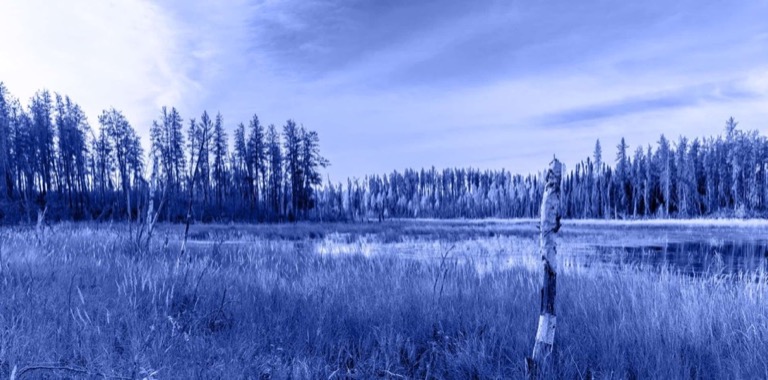
The WBEA created the Community Odour Monitoring Program (COMP) app as an opportunity for people to provide information about the odours they experience throughout the RMWB, as outlined in the image below. Currently, analyzers can measure the concentration of specific pollutants or groups of pollutants, but they cannot measure if an odour is present or how strong the odour would be. Therefore, the app allows the WBEA to compare the information people provide about odours to the ambient air data collected at WBEA air monitoring stations. The intent is to find whether there are trends in the ambient data when odours are present—such as elevated concentrations of odour-causing compounds. Observations are displayed in near-real time on the COMP website.
For more information about the COMP, the 2022 COMP Annual Report, as well as links to download the app on iOS and Android devices visit comp.wbea.org.
Download the free COMP app to anonymously share odour observations with the WBEA:
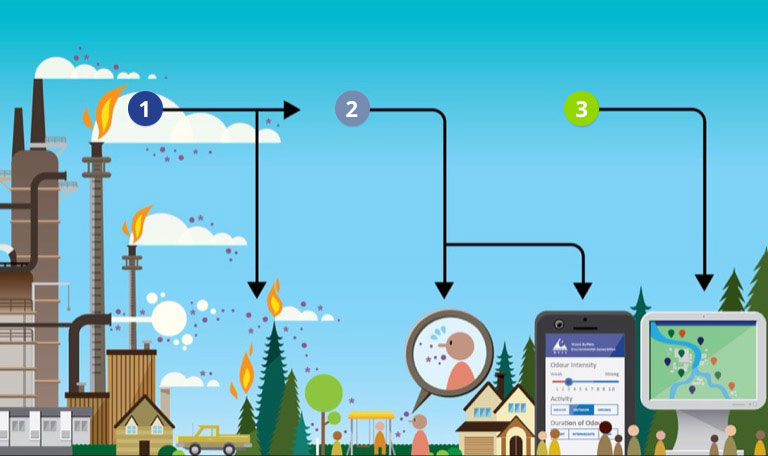
Source
Pollution is emitted into the air from a variety of sources.
Smell
The pollution may cause odours - anyone who experiences an odour in the RMWB can submit their observations via the WBEA’s COMP app.
Share
Users can learn about odours and view all observations submitted at comp.wbea.org.
Athabasca Chipewyan First Nation
Chard Métis Nation
Chipewyan Prairie Dene First Nation
Christina River Dene Nation Council
Conklin Resource Development Advisory Committee
Fort McKay First Nation
Fort McKay Métis Nation
Fort McMurray 468 First Nation
Lakeland Métis Community Association
McMurray Métis
Mikisew Cree First Nation
Keyano College
Pembina Institute
Alberta Energy Regulator
Alberta Environment and Protected Areas
Alberta Health
Alberta Health Services
Environment and Climate Change Canada
Health Canada
Parks Canada
Regional Municipality of Wood Buffalo
Athabasca Oil Corporation
Canadian Natural
Cenovus Energy Inc.
ChemTrade Logistics
CNOOC International
Connacher Oil and Gas Ltd
ConocoPhillips Canada
H.J. Baker Sulphur Canada ULC
Hammerstone Corporation
Harvest Operations Corp.
Imperial Oil Limited
Inter Pipeline Limited
Keyera Energy Ltd.
MEG Energy Corp.
Parsons Creek Aggregates
PetroChina Canada Ltd.
Suncor Energy Inc.
Sunshine Oilsands Ltd.
Surmont Energy
Syncrude Canada Ltd.
Teck Resources Ltd.
Titan Tire Reclamation Corporation
Downloadable PDF of 2022 WBEA Annual Report
Download (43.8MB)